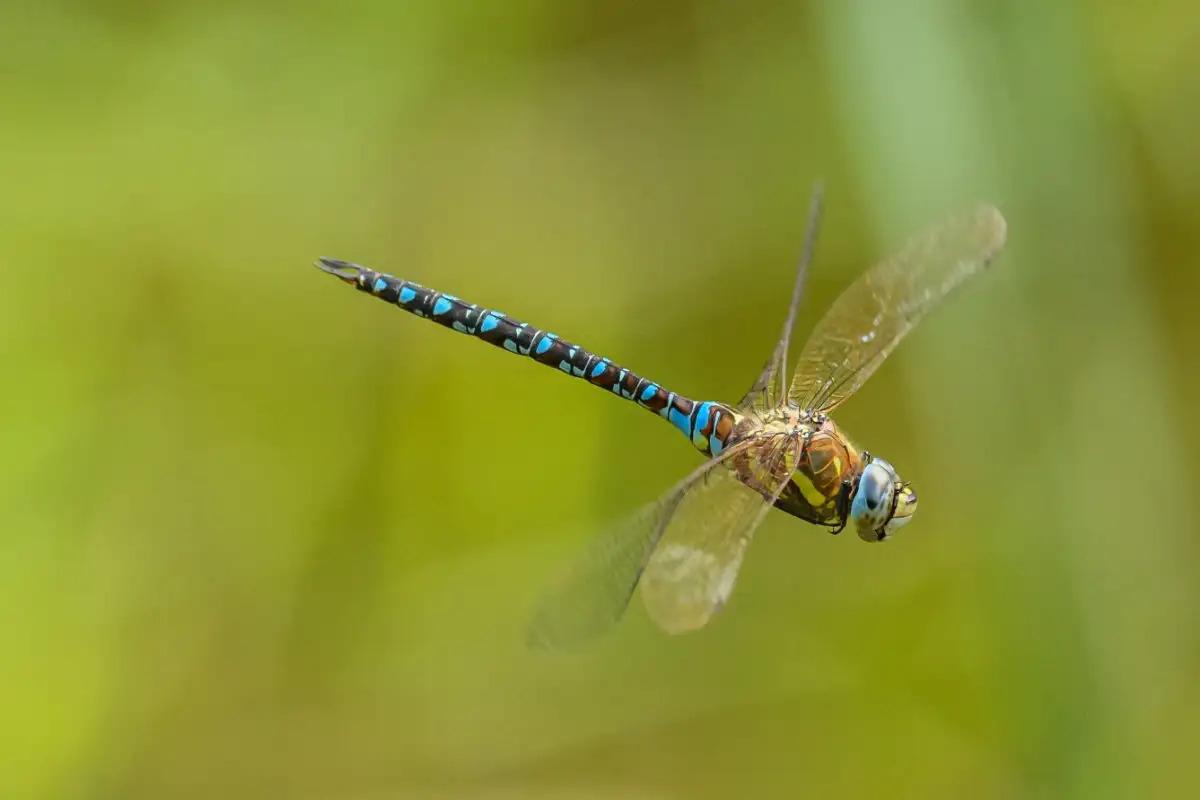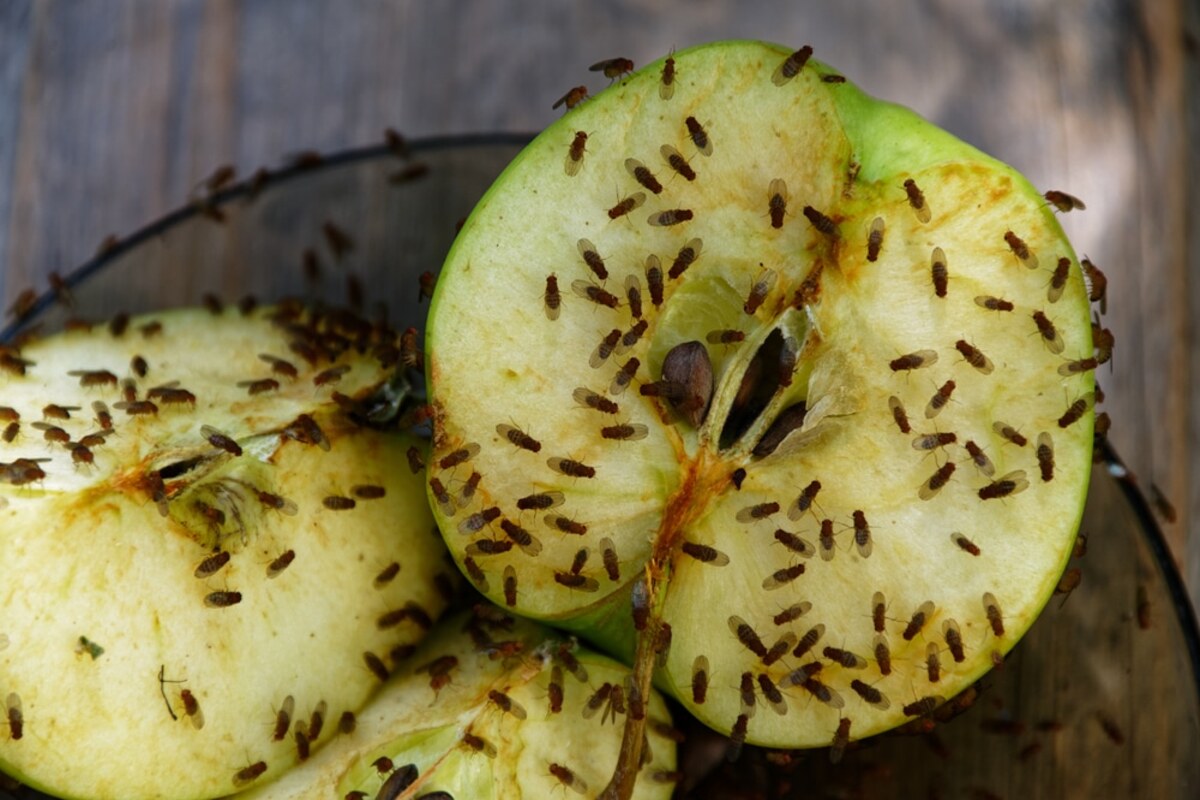Home>Gardening News and Trends>Latest News>How Do Insects Fly?


Latest News
How Do Insects Fly?
Modified: January 22, 2024
Discover the fascinating world of insect flight with the latest news. Learn about their unique adaptations and the mechanics behind their ability to soar through the air.
(Many of the links in this article redirect to a specific reviewed product. Your purchase of these products through affiliate links helps to generate commission for Chicagolandgardening.com, at no extra cost. Learn more)
Table of Contents
Introduction
Have you ever marveled at the graceful flight of a butterfly or the swift maneuvering of a dragonfly? The ability of insects to fly is truly remarkable, and it has intrigued scientists for centuries. Insects, with their delicate wings and seemingly effortless flight, have mastered the skies in ways that humans can only dream of. But how do these tiny creatures achieve such extraordinary feats?
In this article, we will explore the fascinating world of insect flight, delving into the intricate mechanisms and adaptations that allow insects to take to the air. From the basic anatomy of insects to the aerodynamics of their flight, we will uncover the secrets behind their seemingly effortless movement.
Before we delve into the complexities of insect flight, it is important to understand the basic anatomy of these remarkable creatures. Insects, which belong to the class Insecta, have a segmented body consisting of three major parts: the head, thorax, and abdomen.
The head houses the insect’s sensory organs, including the compound eyes, antennae, and mouthparts. The thorax, located in the middle segment, serves as the powerhouse for flight. It contains the muscles that control the movement of the insect’s wings. Finally, the abdomen houses the insect’s internal organs.
One of the defining features of insects and their ability to fly is their specialized wing structure. In most insects, the wings are made up of a thin, lightweight membrane called the wing vein, which is supported by a network of tiny tubular structures called wing veins. These veins provide rigidity to the wings, allowing for controlled and precise movements.
But how exactly do insects move their wings to achieve flight? Unlike birds and bats, which have muscles in their wings, insects rely on the contraction and relaxation of flight muscles in their thorax to power their flight. These muscles are attached to the base of the wings and pull them downward during contraction, generating the necessary lift for flight.
Insect flight can be categorized into two main types: direct flight and indirect flight. In direct flight, insects generate lift by flapping their wings in a figure-eight pattern. This motion creates both lift and thrust, allowing insects to overcome gravity and move forward. Examples of insects that employ direct flight include bees, butterflies, and fruit flies.
Basic Anatomy of Insects
To understand how insects are able to fly, it is important to explore their basic anatomy. Insects, which make up the class Insecta, have a distinct body structure that is adapted for flight.
Insects have three main body segments: the head, thorax, and abdomen. The head contains the sensory organs such as compound eyes, antennae, and mouthparts. These structures play a crucial role in navigating the environment and obtaining food.
The thorax is the central part of the insect’s body and is responsible for generating the necessary power for flight. It houses the flight muscles, which are attached to the wings. Insects have two pairs of wings, one on each side of the thorax.
The wings of insects are one of their most distinctive features. They are thin, transparent structures that are supported by a series of veins. These veins provide strength and rigidity to the wings, allowing for controlled movement during flight.
The structure of insect wings can vary greatly across different species. Some insects have wings with intricate patterns and designs, while others have wings that are plain and simple. The size and shape of the wings can also vary, depending on the insect’s specific needs and adaptations.
In addition to their wings, insects have a unique respiratory system that enables them to take in oxygen and release carbon dioxide. Unlike mammals, who rely on lungs to breathe, insects have a network of tiny tubes called tracheae that carry oxygen directly to their cells.
The abdomen, located at the rear of the insect’s body, houses the reproductive organs and digestive system. It plays a vital role in the insect’s overall physiology and survival.
It is important to note that the anatomy of insects can vary greatly depending on the species. There are more than a million identified species of insects, each with its own unique adaptations and characteristics.
Understanding the basic anatomy of insects is crucial in unraveling the secrets of their flight capabilities. By studying the structure and function of their wings, muscles, and other body parts, scientists can gain valuable insights into the incredible world of insect flight.
Insect Wing Structure
The wings of insects play a pivotal role in their ability to fly. The structure of insect wings is remarkably diverse and well-adapted to meet the demands of flight in various environments.
In most insects, the wings are composed of a thin, lightweight membrane called the wing vein. This membrane is supported by a network of tiny tubular structures known as wing veins. These veins provide rigidity and strength to the wings, allowing for controlled and precise movements during flight.
The arrangement and pattern of wing veins can vary significantly among different insect species. Some insects have a complex network of veins that form intricate patterns, while others have simpler vein arrangements. This diversity in wing vein structure reflects the unique adaptations and flight behaviors of each insect species.
Along with the veins, there may also be specialized structures present on insect wings. These structures can include scales, hairs, or feathery projections. Scales are typically found in butterflies and moths, giving their wings vibrant colors and patterns. Hairs or setae can enhance the aerodynamic properties of the wings, making flight more efficient.
The size and shape of insect wings can vary greatly as well. Some insects, such as beetles, have hardened forewings, called elytra, which serve as protective covers for the hindwings. This unique wing structure provides stability during flight and protection when the insect is at rest.
In certain species of insects, such as flies and mosquitoes, the hindwings are reduced to small, knob-like structures called halteres. These halteres act as gyroscopic sensors, providing information on the insect’s body position and aiding in flight stability.
It is important to note that not all insects have wings. Some species, like ants and bees, have specialized castes or individuals without wings, while others have vestigial wings that are non-functional. This variation in wing presence or structure is a result of evolutionary adaptations to different ecological niches.
The remarkable diversity in insect wing structure is a testament to the adaptability and efficiency of these remarkable creatures. By studying the intricate details of wing morphology, scientists can gain insights into the evolution of flight and the ecological roles that insects play in our world.
Insect Wing Movements
The ability of insects to fly is made possible by the complex movements of their wings. Unlike birds and bats that have muscles within their wings, insects rely on the contraction and relaxation of flight muscles in their thorax to power their flight.
Insect wing movements can be categorized into two main types: flapping and oscillating. Flapping is the most common form of wing movement, where the wings are moved up and down in a figure-eight pattern. This motion generates both lift and thrust, allowing insects to overcome gravity and move forward.
During the upstroke, the wings are tilted upwards, reducing the amount of drag and providing some lift. As the wings move downwards in the downstroke, they generate a significant amount of lift by pushing against the air. This flapping motion creates a propulsive force that propels the insect forward.
In addition to flapping, some insects, such as dragonflies and damselflies, utilize oscillating wing movements. Unlike flapping where the wings move in a vertical plane, oscillating wings move in a horizontal plane. This motion creates lift by pushing the air downwards and generating thrust that propels the insect forward.
The coordination of wing movements is crucial for stable and controlled flight. Insects have specialized flight muscles that are attached to the base of the wings. These muscles contract and relax in an orchestrated manner, generating the necessary force to move the wings and control their motion.
Wing movements are also influenced by the insect’s central nervous system, which sends signals to the flight muscles to adjust the wing motion accordingly. This coordination allows insects to make rapid and precise adjustments in response to changes in their environment, such as gusts of wind or obstacles in their flight path.
It is important to note that the wing movements of insects are highly efficient. The figure-eight flapping motion, in particular, allows insects to generate lift and thrust with minimal energy expenditure. This efficiency enables insects to navigate vast distances, perform intricate aerial maneuvers, and engage in behaviors such as mating displays or foraging.
The remarkable wing movements of insects not only enable their ability to fly but also contribute to the survival and success of these incredible creatures in diverse ecological niches. By studying these movements, scientists gain valuable insights into the mechanisms that underlie insect flight and the adaptations that have evolved over millions of years.
Insect Flight Mechanisms
Insects have evolved various mechanisms to achieve flight, allowing them to navigate their environment with precision and efficiency. These mechanisms are a result of millions of years of evolution, optimizing their ability to take to the skies.
One of the primary mechanisms of insect flight is the generation of lift. Lift is the upward force that counteracts gravity, allowing insects to stay airborne. Insects achieve lift through a combination of wing shape, wing movements, and the production of airflow.
The shape of insect wings, with their characteristic curved upper surface and flatter lower surface, creates a pressure difference known as Bernoulli’s principle. As air flows over the curved upper surface of the wing, it moves faster, creating a region of low pressure. Simultaneously, the air flowing beneath the flatter lower surface moves slower, creating a region of higher pressure. This pressure difference generates lift, allowing the insect to rise and stay in the air.
Another essential mechanism in insect flight is the production of airflow. Insects use their wings to generate a specific pattern of air circulation, known as the vortex ring. During the downstroke, the wings push against the air, creating a vortex of swirling air that gets trapped below the wings. This vortex ring creates additional lift and stability for the insect.
The generation of airflow is also influenced by the complex movements of insect wings. The figure-eight flapping motion of wings, combined with the coordination of flight muscles, creates a continuous flow of air. This flow not only generates lift but also aids in maintaining stability and control during flight.
Insect flight mechanisms are also closely tied to their aerodynamic properties. The small size and lightweight nature of insects allow for increased maneuverability and agility in the air. Additionally, the ability to adjust wing angles, wing speed, and wingbeat frequency in response to environmental factors enables insects to adapt to various flight conditions.
It is fascinating to note that insect flight mechanisms have inspired advancements in human aviation. Engineers and scientists have looked to the intricate mechanisms of insects to design more efficient and maneuverable drones and micro-air vehicles. By understanding the principles behind insect flight, researchers aim to develop innovative technologies that mimic the flight capabilities of these remarkable creatures.
Insect flight mechanisms are a testament to the ingenuity and adaptability of these creatures. By harnessing the power of lift generation, airflow production, and aerodynamics, insects have conquered the skies, occupying diverse habitats and playing critical roles in ecosystems worldwide.
Aerodynamics of Insect Flight
The aerodynamics of insect flight is a fascinating field of study that explores the principles and forces at play when these tiny creatures take to the air. Insects have evolved remarkable adaptations that allow them to defy gravity and maneuver through the air with precision.
One key aspect of insect flight aerodynamics is the generation of lift. As insects flap their wings, the shape and movement of the wings create different air pressures above and below. This pressure difference, known as Bernoulli’s principle, generates lift by creating an upward force that counteracts the weight of the insect. The curved upper surface of the wing creates lower air pressure, while the flat lower surface creates higher air pressure, resulting in upward lift.
The generation of lift in insect flight is also influenced by wing shape and wingbeat frequency. Insects with broader wings, like butterflies, create more lift with slower wingbeats due to the larger surface area. In contrast, insects with narrower wings, like bees, achieve lift with faster wingbeats to compensate for the smaller surface area.
Another important factor in insect flight aerodynamics is the production of airflow. Insects create a vortex ring, a whirlwind of air, by pushing their wings downward during the downstroke. This vortex ring of swirling air provides additional lift and stability, allowing insects to maintain flight. The shape and movement of their wings are crucial in maintaining a steady airflow and optimizing the vortex ring.
Insect flight aerodynamics also involve drag, the resistance experienced by an insect as it moves through the air. Drag can be minimized through streamlined body shapes and efficient wing movements. Insects have adapted various strategies to reduce drag, such as tucking their legs and antennae close to their bodies while in flight. The reduction of drag enables insects to fly faster and more efficiently.
Furthermore, insects utilize an intricate control system to maintain stability and maneuverability during flight. They adjust the angle of their wings, the position and movement of their body, and the speed of their wingbeats to adapt to changes in the environment. This allows insects to make quick turns, hover in mid-air, or navigate obstacles with remarkable precision.
Studying the aerodynamics of insect flight not only provides insights into how these small creatures achieve flight but also offers inspiration for technological advancements. Engineers and researchers look to the flight mechanisms of insects to develop efficient drones and micro-air vehicles that can maneuver and navigate in complex environments.
The remarkable aerodynamics of insect flight demonstrate the efficiency, adaptability, and elegance of these tiny aviators. By harnessing the principles of lift generation, vortex ring formation, and drag reduction, insects have mastered the art of flight, soaring through the air with grace and agility.
Challenges and Adaptations in Insect Flight
Insect flight, although remarkable, presents various challenges that insects have had to overcome through evolutionary adaptations. From battling the forces of gravity to navigating complex environments, insects have developed remarkable strategies to excel in the skies.
One of the significant challenges in insect flight is the issue of size and weight. Insects are small and lightweight, which means they have a relatively high surface-to-volume ratio. This poses challenges in generating sufficient lift to counteract their weight. To overcome this, insects have evolved specialized wing structures, such as wing veins and scales, that provide strength and rigidity while minimizing weight. They also adjust their wingbeat frequency, wing size, and shape to optimize lift generation.
The external environment also presents challenges to insects in flight. Air currents, wind gusts, and turbulence can create unpredictable forces that make flight control difficult. To tackle this, insects have developed exceptional agility and maneuverability. They can adjust their wing movements and body posture on the fly to adapt to changing conditions. Sensitive sensory organs, such as the halteres in flies, provide valuable feedback on body position and movement, aiding in flight stabilization.
Another challenge is navigating complex environments filled with obstacles and varying airflow patterns. Insects have evolved keen visual perception and spatial awareness to detect and avoid obstacles in their flight path. They can make rapid adjustments in their flight trajectory, utilizing their intricate wing movements and flight muscles to navigate challenging terrain.
Insect flight also requires bursts of energy, making efficient energy utilization vital. Insects have adapted by optimizing their flight metabolism and respiratory system. Their tracheal system efficiently delivers oxygen directly to their cells, ensuring a steady supply of energy-rich molecules for flight muscles. Some insects, like bees, can even generate heat through flight muscles to maintain optimal body temperature during colder conditions.
Adaptations in wing morphology and kinematics have also evolved to suit specific flight behaviors and ecological niches. Some insects, like hoverflies, have wings that can beat at an incredibly high frequency, allowing them to hover in place or perform agile maneuvers during flight. Others, like dragonflies, have wings with large surface areas and wide ranges of motion, enabling them to achieve exceptional speed and precision.
These remarkable adaptations in insect flight have allowed them to thrive in diverse habitats and fulfill critical ecological roles. From pollinating plants to controlling pest populations, insects are an integral part of the ecosystem, and their ability to fly has played a crucial role in their success and survival.
By studying the challenges and adaptations in insect flight, scientists gain valuable insights into the principles of flight and potentially inspire advancements in aviation technology. The extraordinary abilities of insects in flight continue to fascinate and serve as a testament to the wonders of the natural world.
Conclusion
Insect flight is a marvel of nature, captivating our imagination and pushing the boundaries of what we thought was possible. From the delicate flutters of a butterfly to the lightning-fast maneuvers of a dragonfly, the ability of insects to defy gravity and navigate the skies is truly awe-inspiring.
We have explored the intricate mechanisms behind insect flight, from the basic anatomy of insects to the structure and movements of their wings. Through millions of years of evolution, insects have developed specialized adaptations that allow them to generate lift, produce airflow, and maintain stability and maneuverability in flight.
But insect flight is not without its challenges. Insects have overcome the obstacles presented by their small size, weight, and unpredictable external forces. They have evolved remarkable adaptations in wing morphology, respiratory systems, and flight control mechanisms to excel in flight and thrive in diverse ecological niches.
Studying insect flight not only deepens our understanding of these fascinating creatures but also has practical implications. Scientists and engineers look to insect flight for inspiration in designing more efficient drones and micro-air vehicles, aiming to replicate the remarkable capabilities of these tiny aviators.
In the end, the wonders of insect flight remind us of the incredible diversity and adaptability of life on Earth. From the smallest beetles to the largest butterflies, each insect species has its own unique flight techniques and adaptations. They fill our world with colors, pollinate our crops, and play vital roles in maintaining ecological balance.
So the next time you see a graceful butterfly dancing on the breeze or a dragonfly darting around a pond, take a moment to marvel at the intricacies of their flight. It is a reminder of the extraordinary beauty and complexity that exists in the natural world, and an inspiration to pursue new horizons in our own human endeavors.










